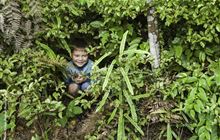Kōwhai
Introduction
The kōwhai is one of the best known native trees in New Zealand and it’s our unofficial national flower.They are best known for their brilliant yellow flowers that appear in profusion in Spring and stand out among the forest greenery. We love to have kōwhai in our gardens. Kōwhai imagery is popular in art works and has been used on postage stamps and coins.
Quick facts
- Kōwhai trees have small leaflets and juvenile branches on some species are twisted and tangled.
- They grow from a seed in the ground to become a tree up to 25 m high.
- It's found throughout New Zealand in a diverse range of habitats from riparian forests, coastal cliff faces to inland grey scrub communities.
- Native birds such as the tui, bellbird, kākā and New Zealand pigeon/kererū/kūkū/kūkupa all benefit from kōwhai trees.
- Tui and bellbird and New Zealand wood pigeon/kererū/kūkū/kūkupa feast on leaves and flowers – kōwhai are an important seasonal nectar food source for them.
- Māori hold the tree in high esteem, valuing the durability of its hard wood and its many medicinal properties.
Kōwhai species
Eight species of kōwhai are now recognised in New Zealand in the genus Sophora. All are endemic to New Zealand.
- S. chathamica,
- S. fulvida,
- S. godleyi,
- S. longicarinata,
- S. prostrata,
- S. microphylla,
- S. molloyi and
- S. tetraptera.
Most species of kōwhai are trees but two species, S. molloyi and S. prostrata, have a prostrate or bushy growth habit. S. prostrata and S. microphylla both have a divaricating juvenile habit which, for S. prostrata, is retained throughout its life.
All species of kōwhai produce pods with abundant hard-coated yellow to yellow-brown seeds. Abrasion of this hard seed coat is needed before germination can happen.
Distribution of kōwhai
Sophora microphylla is the most widespread species of kōwhai being found throughout both the North and South Island.
In the wild, some species are restricted to the North Island (S. fulvida, S. godleyi, S. tetraptera and probably S. chathamica) and others to the South Island (S. longicarinata and S. prostrata).
S. molloyi is a particularly restricted species that's found only on islands in Cook Strait and on headlands along the south Wellington coast.
Kōwhai occupy a wide range of habitats that includes river terraces, dunes, flood plains, lake margins, hill slopes and rocky ground.
Threats
Three species of kōwhai, S. fulvida, S. longicarinata and S. molloyi, are now listed by the New Zealand Threatened Plant Panel as ‘Naturally Uncommon’. This recognises their restricted ranges and suggests some level of conservation monitoring to ensure they aren't in decline.
The other species, while still relatively common, have suffered significant loss of habitat through past forest clearance for agriculture.
In parts of their range, kōwhai are now scarce and those that remain are lone trees or small groves growing in isolation. Such trees are vulnerable to further loss through impacts of stock and lack of regeneration opportunities. In parts of the South Island in particular, rabbits and hares prevent natural recruitment in all but the most inaccessible sites.
You can help
- how to grow kōwhai
- get the best results for your planting and
- protect them from pests.
Use locally sourced kōwhai plants in gardens, shelterbelts, riparian planting and other revegetation projects.
Encourage others (landowners, councils and community groups) to include kōwhai in their planting plans.

